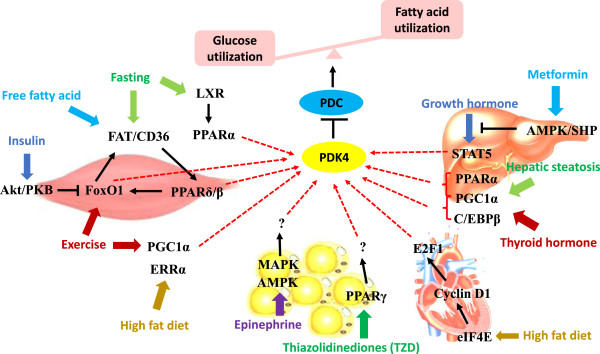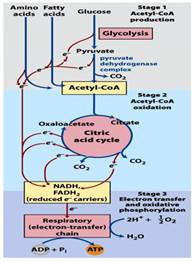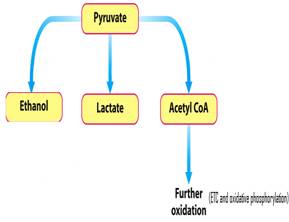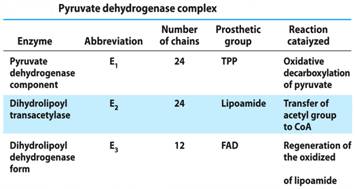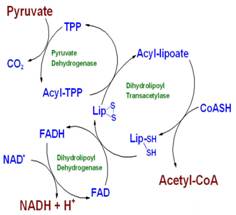Pyruvate Dehydrogenase Complex Deficiency (PDCD)
Zhilwan Rahim
Park University
Introduction
One of the most important molecules in the body undoubtedly is adenosine triphosphate (ATP). The process or pathways of making these molecules is considered even more important. This molecule is important to us, due to the vast requirement of it, which is involved in almost every reaction in the body. It is relatively clear the profound results that would yield in the absence and or decrease of production of this vital molecule. The process of producing ATP is similar to that of a domino effect; it consists of many metabolic pathways that ultimately lead to our product (9).
There are many different sites in this domino effect that are extremely important and necessary in order for things to run smoothly. The site, or rather complex that is going to observed, analyzed, and discussed in detail is the pyruvate dehydrogenase complex (PDC). PDC has a special job in the process of producing ATP. The conversion of pyruvate (product of glycolysis) to acetyl CoA (one of the starting products of the citric acid cycle), is accomplished by this very complex (10). As seen and discussed in great detail later on, this complex is composed of many different proteins and enzymes that work synergistically for the greater good (11).
The specific site (or transition state) in which intermediate products have to be converted for the domino effect to persist is going to be the target of this investigation. The main objectives of this paper is to highlight a specific abnormality at the E1 alpha subunit that can transpire, the mechanism for this abnormality, disorders related to them, differences and similarities in Prokaryotes verse Eukaryotes, and other pathways involved.
Specific Site (PDC)
Like mentioned above, the Pyruvate dehydrogenase complex is extremely important when it comes to ATP production. Although this complex doesn’t directly yield our product, the product that is fabricated by these enzymes have a major role in the proceeding metabolic pathways that lead to ATP production (12).
(
Figure 1.1, central metabolic pathways –
Lehninger Principle of Biochemistry, fifth edition)
So why is PDC so important? Well, one of the biggest functions of this complex is to perform oxidative decarboxylation of Pyruvate (7). In order to fully understand the importance of this complex, a brief discussion of glycolysis is necessary.
In glycolysis, one molecule of glucose (a 6 carbon molecule) is converted into two pyruvate (a 3 carbon molecule) molecules (refer to Figure 1.1). In that process (glycolysis), 2 molecules of ATP are invested to produce pyruvate, which is useless if PDC is not functioning properly.6 At this point, the pyruvate molecule has many fates. As you can see in figure 1.2, one of those paths includes the conversion of Pyruvate to ethanol or lactate (in the absence of oxygen, or abnormalities in the PDC). This occurs in a process called fermentation; the other pathway is the conversion of Pyruvate into acetyl CoA and the further oxidation of this molecule in the Citric Acid Cycle (this leads to the electron transfer chain and oxidative phosphorylation that ultimately synthesizes ATP).7,12
(Figure 1.2 Fates of Pyruvate, Biochemistry: A Short Course, 1st ed)
Components and Mechanism of PDC
PDC is located in the mitochondrial matrix. This complex is composed of 3 enzymes: pyruvate dehydrogenase (E1), dihydrolipoyl transacetylase (E2) and dihydrolipoyl dehydrogenase (E3).7 The complex also requires five cofactors (which are all derived from vitamins) that are vital for proper functioning of the enzymes.12 Furthermore, there are corresponding prosthetic groups that help support the PDC (refer to chart 1.3): TPP (thiamine pyrophosphate), Lipoamide, and FAD (flavin adeninedinucleotide).
(Chart 1.3 PDC. Lehninger Principle of Biochemistry, fifth edition)
The step by step process of how pyruvate is converted into acetyl CoA should be discussed in detail for clarification purposes.
In step 1, pyruvate reacts with the bound thiamine pyrophosphate (TPP) of pyruvate dehydrogenase (E1), undergoing decarboxylation to the hydroxyethyl derivative (see Figure 1.4). Pyruvate dehydrogenase is also responsible for carrying out step 2, the transfer of two electrons and the acetyl group from TPP to the oxidized form of the lipoyllysyl group of the enzyme, dihydrolipoyl transacetylase (E2), to form the acetyl thioester of the reduced lipoyl group. In Step 3 we have a trans-esterification in which the SH group of CoA replaces the SH group of E2 to yield acetyl-CoA and the fully reduced (dithiol) form of the lipoyl group. In step 4 dihydrolipoyl dehydrogenase (E3) promotes the transfer of two hydrogen atoms from the reduced lipoyl groups of E2 to the FAD prosthetic group of E3, restoring the oxidized form of the lipoyllysyl group of E2. In step 5, the reduced FADH2 of E3 transfers a hydride ion to NAD+, forming NADH. The PDC is now ready for another catalytic cycle (5).
(
Figure 1.4 Mechanism of PDC. Biochemistry: A Short Course, 1sted)
To review of what has happened thus far, we took a glucose molecule and produced two molecules of pyruvate through a process called glycolysis. In an oxygen rich environment (and the proper functioning PDC), pyruvate is converted into acetyl CoA through a multi-step, multi-enzyme subunit complex and transferred into the mitochondria. Acetyl CoA is then put into the citric acid cycle (CAC) to propagate another pathway that ultimately leads to the production of reduced FADH+ and NADH2 (4). These electron carriers are going to run through the electron transport chain, which directs ATP synthesis. One can now see the importance of PDC and how it links the metabolic pathways together (8). If an abnormality were to occur, then the outcome would be profound.
E1 Alpha Gene Mutation
Frye and Benke1 state that
“Pyruvate dehydrogenase complex deficiency is one of the most common neurodegenerative disorders associated with abnormal mitochondrial metabolism.” Looking back at the metabolism of glucose, we observed the process by which pyruvate was produced at the

